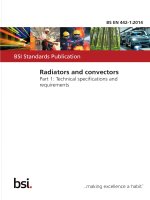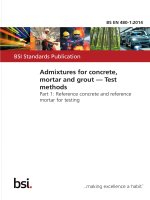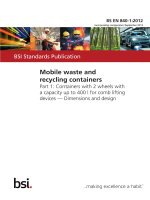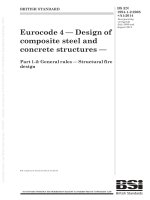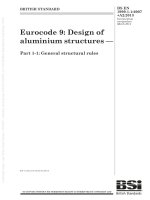Bsi bs en 62074 1 2014
Bạn đang xem bản rút gọn của tài liệu. Xem và tải ngay bản đầy đủ của tài liệu tại đây (2.39 MB, 58 trang )
BS EN 62074-1:2014
BSI Standards Publication
Fibre optic interconnecting
devices and passive
components — Fibre
optic WDM devices
Part 1: Generic specification
BRITISH STANDARD
BS EN 62074-1:2014
National foreword
This British Standard is the UK implementation of EN 62074-1:2014. It
is identical to IEC 62074-1:2014. It supersedes BS EN 62074-1:2009
which is withdrawn.
The UK participation in its preparation was entrusted by Technical
Committee GEL/86, Fibre optics, to Subcommittee GEL/86/2, Fibre optic
interconnecting devices and passive components.
A list of organizations represented on this committee can be obtained on
request to its secretary.
This publication does not purport to include all the necessary provisions of
a contract. Users are responsible for its correct application.
© The British Standards Institution 2014.
Published by BSI Standards Limited 2014
ISBN 978 0 580 78242 8
ICS 33.180.01; 33.180.20
Compliance with a British Standard cannot confer immunity from
legal obligations.
This British Standard was published under the authority of the
Standards Policy and Strategy Committee on 30 April 2014.
Amendments/corrigenda issued since publication
Date
Text affected
BS EN 62074-1:2014
EN 62074-1
EUROPEAN STANDARD
NORME EUROPÉENNE
EUROPÄISCHE NORM
April 2014
ICS 33.180.01; 33.180.20
Supersedes EN 62074-1:2009
English version
Fibre optic interconnecting devices and passive components Fibre optic WDM devices Part 1: Generic specification
(IEC 62074-1:2014)
Dispositifs d'interconnexion et dispositifs
passifs à fibres optiques Dispositifs WDM à fibres optiques Partie 1: Spécification générique
(CEI 62074-1:2014)
Lichtwellenleiter Verbindungselemente und passive
Bauteile Lichtwellenleiter-WDM-Bauteile Teil 1: Fachgrundspezifikation
(IEC 62074-1:2014)
This European Standard was approved by CENELEC on 2014-03-13. CENELEC members are bound to comply
with the CEN/CENELEC Internal Regulations which stipulate the conditions for giving this European Standard
the status of a national standard without any alteration.
Up-to-date lists and bibliographical references concerning such national standards may be obtained on
application to the CEN-CENELEC Management Centre or to any CENELEC member.
This European Standard exists in three official versions (English, French, German). A version in any other
language made by translation under the responsibility of a CENELEC member into its own language and notified
to the CEN-CENELEC Management Centre has the same status as the official versions.
CENELEC members are the national electrotechnical committees of Austria, Belgium, Bulgaria, Croatia, Cyprus,
the Czech Republic, Denmark, Estonia, Finland, Former Yugoslav Republic of Macedonia, France, Germany,
Greece, Hungary, Iceland, Ireland, Italy, Latvia, Lithuania, Luxembourg, Malta, the Netherlands, Norway, Poland,
Portugal, Romania, Slovakia, Slovenia, Spain, Sweden, Switzerland, Turkey and the United Kingdom.
CENELEC
European Committee for Electrotechnical Standardization
Comité Européen de Normalisation Electrotechnique
Europäisches Komitee für Elektrotechnische Normung
CEN-CENELEC Management Centre: Avenue Marnix 17, B - 1000 Brussels
© 2014 CENELEC -
All rights of exploitation in any form and by any means reserved worldwide for CENELEC members.
Ref. No. EN 62074-1:2014 E
BS EN 62074-1:2014
EN 62074-1:2014
-2-
Foreword
The text of document 86B/3700/FDIS, future edition 2 of IEC 62074-1, prepared by SC 86B "Fibre
optic interconnecting devices and passive components" of IEC/TC 86 "Fibre optics" was submitted to
the IEC-CENELEC parallel vote and approved by CENELEC as EN 62074-1:2014.
The following dates are fixed:
–
latest date by which the document has to be implemented at
national level by publication of an identical national
standard or by endorsement
(dop)
2014-12-13
–
latest date by which the national standards conflicting with
the document have to be withdrawn
(dow)
2015-03-13
This document supersedes EN 62074-1:2009.
EN 62074-1:2014 includes
EN 62074-1:2009:
the
following
significant
technical
changes
with
respect
to
–
substantial updating to the definitions;
–
the addition of informative Annexes C to G, giving examples of technical information concerning
WDM devices.
Attention is drawn to the possibility that some of the elements of this document may be the subject of
patent rights. CENELEC [and/or CEN] shall not be held responsible for identifying any or all such
patent rights.
Endorsement notice
The text of the International Standard IEC 62074-1:2014 was approved by CENELEC as a European
Standard without any modification.
BS EN 62074-1:2014
EN 62074-1:2014
-3-
Annex ZA
(normative)
Normative references to international publications
with their corresponding European publications
The following documents, in whole or in part, are normatively referenced in this document and are
indispensable for its application. For dated references, only the edition cited applies. For undated
references, the latest edition of the referenced document (including any amendments) applies.
NOTE When an international publication has been modified by common modifications, indicated by (mod), the
relevant EN/HD applies.
Publication
Year
IEC 60027
Title
EN/HD
Year
series Letter symbols to be used in electrical
technology
EN 60027
series
IEC 60050-731
-
International Electrotechnical Vocabulary
(IEV)
Chapter 731: Optical fibre communication
-
-
IEC 60695-11-5
-
Fire hazard testing
Part 11-5: Test flames - Needle-flame test
method - Apparatus, confirmatory test
arrangement and guidance
EN 60695-11-5
-
IEC 60825-1
-
Safety of laser products
Part 1: Equipment classification and
requirements
EN 60825-1
-
IEC/TR 61931
-
Fibre optic - Terminology
-
-
ISO 129-1
-
Technical drawings - Indication of
dimensions and tolerances
Part 1: General principles
-
-
ISO 286-1
-
Geometrical product specifications (GPS) ISO code system for tolerances on linear
sizes
Part 1: Basis of tolerances, deviations and
fits
EN ISO 286-1
-
ISO 1101
-
Geometrical product specifications (GPS) Geometrical tolerancing - Tolerances of
form, orientation, location and run-out
EN ISO 1101
-
ISO 8601
-
Data elements and interchange formats Information interchange - Representation of
dates and times
-
–2–
BS EN 62074-1:2014
62074-1 © IEC:2014(E)
CONTENTS
1
Scope .............................................................................................................................. 7
2
Normative references ...................................................................................................... 7
3
Terms and definitions ...................................................................................................... 8
4
3.1
Basic term definitions ......................................................................................... 8
3.2
Component definitions ....................................................................................... 9
3.3
Performance parameter definitions .................................................................. 10
Requirements ................................................................................................................ 25
4.1
4.2
4.3
4.4
4.5
4.6
4.7
Annex A
Classification ................................................................................................... 25
4.1.1
General .......................................................................................... 25
4.1.2
Type ............................................................................................... 25
4.1.3
Style ............................................................................................... 25
4.1.4
Variant ............................................................................................ 26
4.1.5
Assessment level ............................................................................ 26
4.1.6
Normative reference extension ....................................................... 27
Documentation ................................................................................................. 27
4.2.1
Symbols ......................................................................................... 27
4.2.2
Specification system ....................................................................... 27
4.2.3
Drawings ........................................................................................ 28
4.2.4
Measurements ................................................................................ 29
4.2.5
Test data sheets ............................................................................. 29
4.2.6
Instructions for use ......................................................................... 29
Standardization system .................................................................................... 29
4.3.1
Performance standards ................................................................... 29
4.3.2
Reliability standard ......................................................................... 30
4.3.3
Interlinking ...................................................................................... 30
Design and construction ................................................................................... 31
4.4.1
Materials ........................................................................................ 31
4.4.2
Workmanship .................................................................................. 31
Performance requirements ............................................................................... 31
Identification and marking ................................................................................ 31
4.6.1
General .......................................................................................... 31
4.6.2
Variant identification number .......................................................... 31
4.6.3
Component marking ........................................................................ 32
4.6.4
Package marking ............................................................................ 32
Safety .............................................................................................................. 32
(informative) Transfer matrix .................................................................................. 34
A.1
General ............................................................................................................ 34
A.2
Transfer matrix ................................................................................................ 34
A.3
Transfer matrix coefficient ................................................................................ 35
A.4
Logarithmic transfer matrix .............................................................................. 35
Annex B (informative) Specific performances of WDM devices for bidirectional
transmission system (example) ...................................................................................... 37
B.1
Generic ............................................................................................................ 37
B.2
Definition of near-end isolation and near-end crosstalk .................................... 38
Annex C (informative) Transfer matrix as applications of WDM devices (example) ............... 40
BS EN 62074-1:2014
62074-1 © IEC:2014(E)
–3–
C.1
Generic ............................................................................................................ 40
C.2
Wavelength multiplexer .................................................................................... 40
C.3
Wavelength demultiplexer ................................................................................ 41
C.4
Wavelength multiplexer/demultiplexer .............................................................. 42
C.5
Wavelength router............................................................................................ 43
C.6
Wavelength channel add/drop .......................................................................... 44
Annex D (informative) Example of technology of thin film filter WDM devices ....................... 46
D.1
General ............................................................................................................ 46
D.2
Thin film filter technology ................................................................................. 46
D.3
Typical characteristics of thin film filter ............................................................ 47
Annex E (informative) Example of technology of fibre fused WDM devices ........................... 48
E.1
General ............................................................................................................ 48
E.2
Typical characteristics of fibre fused WDM devices .......................................... 49
Annex F (informative) Example of arrayed waveguide grating (AWGs) technology .............. 50
F.1
General ............................................................................................................ 50
F.2
Typical characteristics of AWG ........................................................................ 50
Annex G (informative) Example of FBG filter technology ...................................................... 52
G.1
General ............................................................................................................ 52
G.2
Typical characteristics of FBG filter .................................................................. 53
Bibliography .......................................................................................................................... 54
Figure 1 – Example of a six-port device, with two input and four output ports .......................... 8
Figure 2 – Illustration of channel wavelength range .............................................................. 11
Figure 3 – Illustration of insertion loss .................................................................................. 12
Figure 4 – Illustration of ripple .............................................................................................. 12
Figure 5 – Illustration of channel insertion loss variation ....................................................... 13
Figure 6 – Illustration of isolation wavelength........................................................................ 14
Figure 7 – Illustration of isolation wavelength range .............................................................. 15
Figure 8 – Illustration of adjacent channel isolation ............................................................... 16
Figure 9 – Illustration of non-adjacent channel isolation ........................................................ 17
Figure 10 – Illustration of maximum adjacent channel crosstalk ............................................ 18
Figure 11 – Illustration of maximum non-adjacent channel crosstalk ..................................... 19
Figure 12 – Illustration of channel extinction ratio ................................................................. 21
Figure 13 – Illustration of free spectral range ........................................................................ 22
Figure 14 – Illustration of polarization dependent centre wavelength (PDCW) ....................... 23
Figure 15 – Illustration of X dB bandwidth ............................................................................. 25
Figure 16 – Wavelength-selective branching device .............................................................. 26
Figure 17 – Wavelength-selective branching device .............................................................. 26
Figure 18 – Wavelength-selective branching device .............................................................. 26
Figure 19 – Wavelength-selective branching device .............................................................. 26
Figure A.1 – Example of a six-port device, with two input and four output ports .................... 34
Figure A.2 – Illustration of transfer matrix coefficient ............................................................ 35
Figure B.1 – Uni-directional and bi-directional transmission system application of a
1 x 2 DM device .................................................................................................................... 37
Figure B.2 – Illustration of a four-wavelength bidirectional system ........................................ 39
–4–
BS EN 62074-1:2014
62074-1 © IEC:2014(E)
Figure C.1 – Example of a wavelength multiplexer ................................................................ 40
Figure C.2 – Example of a wavelength demultiplexer ............................................................ 41
Figure C.3 – Example of a wavelength multiplexer/demultiplexer .......................................... 42
Figure C.4 – Example of a wavelength router ........................................................................ 43
Figure C.5 – Example of wavelength channel add/drop ......................................................... 44
Figure D.1 – Schematic configuration of a thin film filter WDM device ................................... 46
Figure D.2 – Structure of multilayer thin film ......................................................................... 47
Figure D.3 – Typical characteristics of 1 510 nm and C-band WDM device using thin
film filter technology .............................................................................................................. 47
Figure E.1 – Structure of a fused bi-conical tapered 2x2 coupler ........................................... 48
Figure E.2 – Typical scheme for a fused coupler ................................................................... 49
Figure E.3 – Typical characteristics of a fibre fused WDM device.......................................... 49
Figure F.1 – Basic configuration of AWG .............................................................................. 50
Figure F.2 – Example of AWG characteristics ....................................................................... 51
Figure G.1 – Usage of fibre Bragg grating filter ..................................................................... 52
Figure G.2 – Function and mechanism of fibre Bragg grating ................................................ 52
Figure G.3 – Example of FBG filter characteristics ................................................................ 53
Table 1 – Three-level IEC specification structure .................................................................. 27
Table 2 – Standards interlink matrix ...................................................................................... 31
BS EN 62074-1:2014
62074-1 © IEC:2014(E)
–7–
FIBRE OPTIC INTERCONNECTING DEVICES AND
PASSIVE COMPONENTS – FIBRE OPTIC WDM DEVICES –
Part 1: Generic specification
1
Scope
This part of IEC 62074 applies to fibre optic wavelength division multiplexing (WDM) devices.
These have all of the following general features:
•
they are passive, in that they contain no optoelectronic or other transducing elements;
however they may use temperature control only to stabilize the device characteristics;
they exclude any optical switching functions;
•
they have three or more ports for the entry and/or exit of optical power, and share optical
power among these ports in a predetermined fashion depending on the wavelength;
•
the ports are optical fibres, or optical fibre connectors.
This standard establishes uniform requirements for the following:
•
optical, mechanical and environmental properties.
2
Normative references
The following documents, in whole or in part, are normatively referenced in this document and
are indispensable for its application. For dated references, only the edition cited applies. For
undated references, the latest edition of the referenced document (including any
amendments) applies.
IEC 60027 (all parts), Letter symbols to be used in electrical technology
IEC 60050-731, International Electrotechnical Vocabulary – Chapter
communication
731: Optical fibre
IEC 60695-11-5, Fire hazard testing – Part 11-5: Test flames – Needle-flame test method –
Apparatus, confirmatory test arrangement and guidance
IEC 60825-1, Safety of laser products – Part 1: Equipment classification and requirements
IEC 61931, Fibre optics – Terminology
ISO 129-1, Technical drawings – Indication of dimensions and tolerances – Part 1: General
principles
ISO 286-1, Geometrical product specifications (GPS) – ISO coding system for tolerances of
linear sizes – Part 1: Bases of tolerances and fits
ISO 1101, Geometrical product specifications (GPS) – Geometrical tolerancing – Tolerances
of form, orientation, location and run-out
ISO 8601, Data elements and
Representation of dates and times
interchange
formats
–
Information
interchange
–
BS EN 62074-1:2014
62074-1 © IEC:2014(E)
–8–
3
Terms and definitions
For the purposes of this document, the terms and definitions given in IEC 60050-731, as well
as the following, apply.
3.1
Basic term definitions
3.1.1
port
optical fibre or optical fibre connector attached to a passive device for the entry and/or exit of
the optical power
3.1.2
transfer matrix
optical properties of a fibre optic wavelength-selective branching device can be defined in
terms of an n x n matrix of coefficients, where n is the number of ports, and the coefficients
represent the fractional optical power transferred between designated ports
Note 1 to entry: A detailed explanation of the transfer matrix is shown in Annex A. The ports are numbered
sequentially, so that the transfer matrix is developed to show all ports and all possible combinations. The port
numbering is arbitrary.
Note 2 to entry: Figure 1 below shows an example of a six-port device, with two input ports and four output ports.
This WDM device can operate as four input ports and two output ports for their reciprocity characteristics. Also, it
shall be noted that a combination of input and output port number can be selected, for example, 1 input port and 5
output ports, 3 input ports and 3 output ports and so on, especially for bi-directional transmission system
application. Refer to Annex B.
Inputs
1
2
Outputs
3
4
5
6
IEC 0069/14
Figure 1 – Example of a six-port device, with two input and four output ports
Note 3 to entry: If there are four operating wavelengths, then the resulting transfer matrix becomes a 6 × 6 × 4
matrix: Optical attenuation at λ 1 from port 1 to port 6 would use a 161 . Return loss of port 2 at λ 4 would use a 224 .
Optical attenuation from port 5 to port 2 at λ 3 would use a 523 .
3.1.3
transfer matrix coefficient
element t ij of the transfer matrix
Note 1 to entry:
t ij is the number of more than or equal to zero, and less than or equal to one.
Note 2 to entry:
A detailed explanation is shown in Annex A.
3.1.4
logarithmic transfer matrix
transfer matrix whose matrix element a ij is a logarithmic value of transfer matrix element t ij . a ij
is a number of positive and expressed in dB
Note 1 to entry:
A detailed explanation is shown in Annex A.
BS EN 62074-1:2014
62074-1 © IEC:2014(E)
–9–
3.1.5
conducting port pair
port pair consisting of i and j where t ij is nominally greater than zero (ideally t ij is 1 and a ij is
0) at a specified wavelength
3.1.6
isolated port pair
pair i and j consisting where t ij is nominally zero, and a ij is nominally infinite at a specified
wavelength
3.1.7
channel
wavelength (frequency) band in which an optical signal is transmitted for a WDM device
Note 1 to entry:
WDM devices have two or more channels.
3.1.8
channel spacing
centre-to-centre differences in frequency or wavelength between adjacent channels in a WDM
device
3.2
Component definitions
3.2.1
wavelength-selective branching device
passive component with three or more ports that shares optical power among its ports in a
predetermined fashion, without any amplification or other active modulation but only
depending on the wavelength, in the sense that at least two different wavelength ranges are
nominally transferred between two different pairs of ports
3.2.2
wavelength division multiplexing device
wavelength division multiplexer
WDM device
synonym for a wavelength-selective branching device
Note 1 to entry: The term of wavelength-selective device is the contrast with the term of non-wavelength-selective
branching device. The term of WDM device is frequently used.
3.2.3
dense wavelength division multiplexing device
DWDM device
WDM device which is intended to operate for a channel spacing equal or less than 1 000 GHz
(approximately 8 nm at 1 550 nm and 5,7 nm at 1 310 nm)
3.2.4
coarse wavelength division multiplexing device
CWDM device
WDM device which is intended to operate for channel spacing less than 50 nm and greater
than 1 000 GHz
3.2.5
wide WDM device
WWDM
WDM device which is intended to operate for channel spacing equal to or greater than 50 nm
– 10 –
BS EN 62074-1:2014
62074-1 © IEC:2014(E)
3.2.6
wavelength multiplexer
MUX
WDM (DWDM, CWDM or WWDM) device which has n input ports and one output port, and
whose function is to combine n different optical signals differentiated by wavelength from n
corresponding input ports on to a single output port
3.2.7
wavelength demultiplexer
DEMUX
WDM (DWDM, CWDM or WWDM) device which has one input port and n output ports, and
whose function is to separate n different optical signals differentiated by wavelength from a
single input port to n corresponding output ports
3.2.8
interleaver
DWDM device which has three ports, and which function is to separate n different optical
signals differentiated by wavelength from a common port and transmit an odd channel signal
to one branching port and an even channel signal to the other branching port alternately
Note 1 to entry:
3.3
An interleaver can operate as a wavelength multiplexer (OMUX) by reversing the demultiplexer.
Performance parameter definitions
3.3.1
operating wavelength
nominal wavelength λ h at which a WDM device operates with the specified performance
Note 1 to entry: The term "operating wavelength" includes the wavelength to be nominally transmitting,
designated attenuating and isolated.
Note 2 to entry:
Operating frequency is also used for DWDM devices.
3.3.2
operating wavelength range
specified range of wavelengths including all operating wavelengths
Note 1 to entry:
It includes all passbands and isolation wavelength ranges corresponding to all channels.
Note 2 to entry:
The term "operating wavelength range" is defined for a WDM device, not for each channel or port.
3.3.3
channel wavelength range
range within which a CWDM or WWDM device operates with less than or equal to a specified
optical attenuation for the conducting port pair
Note 1 to entry: For a particular nominal channel centre wavelength, λ nom , this wavelength range from λ imin =
( λ nom - ∆λ max ) to λ imax = ( λ nom + ∆λ max ), where ∆λ max is the maximum channel centre wavelength deviation.
Note 2 to entry: For CWDM devices, channel centre wavelengths and maximum channel centre wavelength
deviations are defined as nominal central wavelengths and wavelength deviations in ITU-T. G 694.2.
Note 3 to entry:
An illustration of channel wavelength range is shown in Figure 2.
BS EN 62074-1:2014
62074-1 © IEC:2014(E)
– 11 –
Optical attenuation (dB)
50
Channel
wavelength
rangefor
channel h
0
λh
λ hmin
a ij
a im
Channel
wavelength
range for
channel k
λk
λ hmax
λ kmin λ kmax
Wavelength
IEC 0070/14
Figure 2 – Illustration of channel wavelength range
3.3.4
channel frequency range
frequency range within which a DWDM device is required to operate with less than or equal to
a specified optical attenuation for the conducting port pair
Note 1 to entry: For a particular nominal channel frequency, f nomi , this frequency range is from f imin = (f nomi ∆ f max ) to fimax = (f nomi + ∆ f max ), where ∆ f max is the maximum channel centre frequency deviation.
Note 2 to entry: Nominal channel centre frequency and maximum channel centre frequency deviation are defined
in ITU-T. G.694.1.
3.3.5
passband
channel passband
synonym for channel wavelength range (channel frequency range)
Note 1 to entry:
Passband is frequently used.
Note 2 to entry:
each channel.
There are two or more passbands for WDM devices. Each passband is defined corresponding to
3.3.6
insertion loss
maximum value of a ij (where i ≠ j) within the passband for conducting port pair
Note 1 to entry: It is the optical attenuation from a given port to a port which is another port of conducting port
pair of the given port of a WDM device. Insertion loss is a positive value in decibels. It is calculated as:
P
IL = −10 log out
Pi n
where
P in
is the optical power launched into the port;
P out
is the optical power received from the other port of the conducting port pair.
Note 2 to entry:
An illustration of insertion loss is shown in Figure 3.
BS EN 62074-1:2014
62074-1 © IEC:2014(E)
– 12 –
λh
0
λ hmin
Maximum insertion loss
for channel h
Passband
for
channel h
λ hmax
Passband
for
channel k
λk
a ij
a im
Maximum insertion loss
for channel k
Optical attenuation (dB)
50
λ kmin λ kmax
Wavelength
IEC 0071/14
Figure 3 – Illustration of insertion loss
Note 3 to entry: For a WDM device, the insertion loss shall be specified as a maximum value of the insertion
losses of all channels
3.3.7
channel insertion loss
term used for WDM devices which has a similar same meaning as insertion loss except that
channel insertion loss is used for a channel whereas insertion loss is used in the
specifications of both a WDM device and for a channel
3.3.8
passband ripple
maximum peak-to-peak variation of the insertion loss (absolute value) over the passband
(within a channel frequency or wavelength range) (refer to Figure 4 below)
50
Optical attenuation (dB)
Channel frequency
(or wavelength) range
Channel frequency
(or wavelength) range
Ripple
Ripple
0
Frequency (or wavelength)
IEC 0072/14
Figure 4a – Ripple at band edges
Figure 4b – Ripple in band
Figure 4 – Illustration of ripple
BS EN 62074-1:2014
62074-1 © IEC:2014(E)
– 13 –
3.3.9
maximum channel insertion loss deviation
maximum variation of the insertion loss (absolute value) within the passband (channel
frequency range for a DWDM device or channel wavelength range for a coarse WDM (CWDM)
and a wide WDM (WWDM) device) (See Figure 5)
Note 1 to entry:
Channel insertion loss deviation should not to be confused with ripple defined in Figure 5 below.
50
Optical attenuation (dB)
Channel centre frequency
(or wavelength)
Channel frequency range for DWDM
devices, channel wavelength range for
CWDM and WWDM devices)
Insertion loss
characteristics for three
temperatures
0
Maximum channel
insertion loss
deviation
Frequency (THz) for DWDM devices, wavelength (nm) for CWDM and WWDM devices
IEC 0073/14
Figure 5 – Illustration of channel insertion loss variation
3.3.10
channel non-uniformity
insertion loss channel non-uniformity
for a specified set of branching ports the difference between the maximum and the minimum
insertion loss at the common port
Note 1 to entry: Channel non-uniformity is defined for a MUX (N x 1 WDM device) and a DEMUX (1 x N WDM
device). Channel non-uniformity is a positive value, and expressed in dB.
Note 2 to entry: For CWDM and DWDM devices, channel non-uniformity should be defined as the differences
between the maximum and the minimum insertion loss at nominal wavelengths (frequencies) of all channels.
3.3.11
centre wavelength deviation
difference between the centre wavelength and nominal wavelength (frequency) of the
specified channel for DWDM devices, where the centre wavelength is defined as the centre of
the wavelength range which is x dB less than the minimum optical attenuation for the
specified passband (channel)
Note 1 to entry:
0,5, 1 or 3 are generally used for x.
BS EN 62074-1:2014
62074-1 © IEC:2014(E)
– 14 –
3.3.12
crosstalk
for WDM devices, the value of the ratio between the optical power of the specified signal and
the specified noise
Note 1 to entry: Crosstalk is a negative value given in dB. The crosstalk is defined for each output port. Crosstalk
for WDM devices is defined for a DEMUX (1 x N WDM device). The crosstalk for port o to port j is subtraction from
the insertion loss of port i to o (conducting port pair) to the isolation of port j to o (isolated port pair). Crosstalk for
WDM devices is defined for a DEMUX (1 x N WDM device). For an MxN WDM device, crosstalk can be defined to
as expanding M of a 1 x N WDM device.
Note 2 to entry: For WDM devices with three of more ports, the crosstalk should be specified as the maximum
value of the crosstalk for each output port.
Note 3 to entry:
Care should be taken not to confuse crosstalk and isolation.
3.3.13
isolation
minimum value of a ij (where i ≠ j) within isolation wavelength range for isolated port pair
Note 1 to entry:
Isolation is a positive value expressed in dB.
3.3.14
isolation wavelength
for a pair of ports i and j (where i ≠ j), that are conducting port pair at a wavelength λ h , a
nominal wavelength λ k (where λ h ≠ λ k ), that is an operating wavelength for a different pair of
ports, at which i and j are isolated port pair (refer to Figure 6 below)
Note 1 to entry:
Isolation frequency is also used for DWDM device.
Optical attenuation (dB)
50
aij
aim
0
λh
Operating
wavelength
λk
Isolation wavelength
Wavelength
IEC 0074/14
Figure 6 – Illustration of isolation wavelength
3.3.15
isolation wavelength range
for a pair of ports i and j that are a conducting port pair at wavelength λ h , the range of
wavelengths from λ kmin to λ kmax centred about an operating wavelength λ k that is an
operating wavelength for a different pair of ports but at which i and j are an isolated port pair
(refer to Figure 7 below)
Note 1 to entry:
Isolation frequency range is also used for DWDM devices.
BS EN 62074-1:2014
62074-1 © IEC:2014(E)
– 15 –
Optical attenuation (dB)
50
a ij
a im
0
λh
λkmin
λk
λkmax
Isolation wavelength range
Wavelength
IEC 0075/14
Figure 7 – Illustration of isolation wavelength range
3.3.16
wavelength isolation
value of a ij (where i ≠ j) in the isolation wavelength range
Note 1 to entry: The wavelength isolation shall be defined as the minimum value of wavelength isolation over the
isolation wavelength range.
3.3.17
adjacent channel isolation
isolation with the restriction that x, the isolation wavelength number, is restricted to the
channels immediately adjacent to the (channel) wavelength number associated with port o
Note 1 to entry:
Adjacent channel isolation is a positive value expressed in dB
Note 2 to entry: This is illustrated in Figure 8 below. The adjacent channel isolation is different from adjacent
channel crosstalk. In Figure 8, the upward-pointing arrow indicates a positive value, and the downward-pointing
arrow indicates a negative value. Generally, there are two adjacent channel isolations for the shorter wavelength
(higher frequency) side and the longer wavelength (lower frequency) side.
3.3.18
adjacent channel crosstalk
crosstalk with the restriction that x, the isolation wavelength number, is restricted to the
channels immediately adjacent to the (channel) wavelength number associated with port o
Note 1 to entry:
Adjacent channel crosstalk is a negative value expressed in dB.
Note 2 to entry: This is illustrated in Figure 8 below. Adjacent channel crosstalk is different from adjacent channel
isolation. In Figure 8, the upward-pointing arrow indicates a positive value, and the downward-pointing arrow
indicates a negative value. Generally, there are two adjacent channel crosstalks for the shorter wavelength (higher
frequency) side and the longer wavelength (lower frequency) side.
– 16 –
0
aiox
Channel centre
frequency
(wavelength)
Adjacent channel Non-adjacent
centre frequency channel centre
(wavelength)
frequency
(wavelength)
Adjacent channel crosstalk
Adjacent channel
centre frequency
(wavelength)
Adjacent channel isolation
Optical attenuation (dB)
50
Non-adjacent
channel centre
frequency
(wavelength)
BS EN 62074-1:2014
62074-1 © IEC:2014(E)
aioc
Frequency (THz) for DWDM devices, wavelength (nm) for CWDM and WWDM devices
IEC 0076/14
Figure 8 – Illustration of adjacent channel isolation
3.3.19
non-adjacent channel isolation
isolation with the restriction that the isolation wavelength (frequency) is restricted to each of
the channels not immediately adjacent to the channel associated with port o (refer to Figure 9
below)
Note 1 to entry: The non-adjacent channel isolation is different from non-adjacent channel crosstalk. In Figure 9,
the upward-pointing arrow indicates a positive value, and the downward-pointing arrow indicates a negative value.
3.3.20
non-adjacent channel crosstalk
crosstalk where the isolation wavelength (frequency) is restricted to each of the channels not
immediately adjacent to the channel associated with port o (refer to Figure 9 below)
Note 1 to entry: Non-adjacent channel crosstalk is different from non-adjacent channel isolation. In Figure 9, the
upward-pointing arrow indicates a positive value, and the downward-pointing arrow indicates a negative value.
BS EN 62074-1:2014
62074-1 © IEC:2014(E)
0
a iox
Adjacent channel
centre frequency
(wavelength)
Channel centre
frequency
(wavelength)
Adjacent channel
centre frequency
(wavelength)
Non-adjacent
channel centre
frequency
(wavelength)
Non-adjacent channel crosstalk
Non-adjacent channel isolation
Optical attenuation (dB)
50
Non-adjacent
channel centre
frequency
(wavelength)
– 17 –
aioc
Frequency (THz) for DWDM devices, wavelength (nm) for CWDM and WWDM devices
IEC 0077/14
Figure 9 – Illustration of non-adjacent channel isolation
3.3.21
minimum adjacent channel isolation
minimum value of a ij within the adjacent operating wavelength (or frequency) range (adjacent
channel passband). The minimum adjacent channel isolation is positive in dB
Note 1 to entry: Refer to Figure 10 below. Generally, there are two minimum adjacent channel isolations. For a
channel, the minimum value of two minimum adjacent channel isolations is selected.
Note 2 to entry: The minimum adjacent channel isolation is different from the maximum adjacent channel
crosstalk. In Figure 10, the upward-pointing arrow indicates a positive value, and the downward-pointing arrow
indicates a negative value.
3.3.22
maximum adjacent channel crosstalk
maximum value of adjacent channel crosstalk within adjacent channel wavelength (frequency)
range (adjacent channel passband)
Note 1 to entry: This is the maximum value of the subtraction from the maximum insertion loss to the minimum
adjacent isolation. Maximum adjacent channel crosstalk is negative value in dB. Refer to Figure 10 below.
Generally, there are two maximum adjacent channel crosstalks. For a channel, the maximum value of two
maximum adjacent channel crosstalks is selected.
Note 2 to entry: The maximum adjacent channel crosstalk is different from the minimum adjacent channel
isolation. In Figure 10, the upward-pointing arrow indicates a positive value, and the downward-pointing arrow
indicates a negative value.
BS EN 62074-1:2014
62074-1 © IEC:2014(E)
– 18 –
0
Adjacent
channel
frequency
(wavelength)
range
Maximum adjacent channel crosstalk
Optical attenuation (dB)
Non-adjacent
channel
frequency
(wavelength)
range
Adjacent channel
centre frequency
(wavelength)
Adjacent channel
centre frequency
(wavelength)
Channel centre
frequency
(wavelength)
Adjacent channel
frequency
(wavelength)
range
Channel centre
frequency
(wavelength)
range
aioc
a iox
Non-adjacent
channel centre
frequency
(wavelength)
Non-adjacent
channel
frequency
(wavelength)
range
Minimum adjacent channel isolation
50
Non-adjacent
channel centre
frequency
(wavelength)
Frequency (THz) for DWDM devices, wavelength (nm) for CWDM and WWDM devices
IEC 0078/14
Figure 10 – Illustration of maximum adjacent channel crosstalk
3.3.23
minimum non-adjacent channel isolation
minimum difference between the minimum peak of a ij in the operating wavelength (or
frequency) range and the maximum value of a ij in a specified range of wavelengths (or
frequencies) from λ kmin to λ kmax centred about an isolation wavelength (or frequency) λ k for
any two ports i and j, λ kmin and λ kmax defining an operating wavelength (or frequency) range
for a different pair of ports for which λ k is an operating wavelength (or frequency) (refer to
Figure 11 below).
Note 1 to entry: The minimum adjacent channel isolation is different from the maximum adjacent channel
crosstalk. In Figure 10, the upward-pointing arrow indicates a positive value, and the down-pointing arrow indicates
a negative value.
3.3.24
maximum non-adjacent channel crosstalk
minimum difference between the minimum peak of a ij in the operating wavelength (or
frequency) range and the maximum value of a ij in a specified range of wavelengths (or
frequencies) from λ kmin to λ kmax centred about an isolation wavelength (or frequency) λ k for
any two ports i and j, λ kmin and λ kmax defining an operating wavelength (or frequency) range
for a different pair of ports for which λ k is an operating wavelength (or frequency) (refer to
Figure 11 below)
Note 1 to entry: The minimum adjacent channel isolation is different from the maximum adjacent channel
crosstalk. In Figure 10, the upward-pointing arrow indicates a positive value, and the downward-pointing arrow
indicates a negative value.
BS EN 62074-1:2014
62074-1 © IEC:2014(E)
Channel centre
frequency (wavelength)
Adjacent channel
frequency
(wavelength)
range
Channel centre
frequency
(wavelength)
range
Adjacent channel
centre frequency
(wavelength)
Adjacent channel
frequency
(wavelength)
range
Non-adjacent
channel centre
frequency
(wavelength)
Non-adjacent
channel
frequency
(wavelength)
range
aioc
aiox
Maximum non-adjacent channel isolation
0
Non-adjacent
channel
frequency
(wavelength)
range
Adjacent channel
centre frequency
(wavelength)
Maximum non-adjacent channel crosstalk
Optical attenuation (dB)
50
Non-adjacent
channel centre
frequency
(wavelength)
– 19 –
Frequency (THz) for DWDM devices, wavelength (nm) for CWDM and WWDM devices
IEC 0079/14
Figure 11 – Illustration of maximum non-adjacent channel crosstalk
3.3.25
total channel isolation
for any two ports i and j (where i ≠ j) it is the cumulative isolation due to the contributions at
all the isolation wavelengths (frequencies) and is defined as:
N
I tot = −10 × Log
tij (λk )
k ( k ≠ h )
∑
where
N
is the number of channels of the device;
H
is the channel number corresponding to the conducting port pair of i and j;
λk
are the nominal isolation wavelengths (frequencies) for the same pair of ports.
Note 1 to entry: Total channel isolation is positive in dB. For a WDM device, total channel isolation shall be
specified as a minimum value of the total channel isolations of all channels
3.3.26
total channel crosstalk
for any two ports i and j (where i ≠ j) it is the ratio of cumulative isolation due to the
contributions at all the isolation wavelengths (frequencies) and transfer matrix coefficient for
ports i and j, t ij and is defined as:
tij (λh )
XTtot = −10 × Log
N
tij (λk )
k (k ≠ h )
∑
BS EN 62074-1:2014
62074-1 © IEC:2014(E)
– 20 –
where
N
is the number of channels of the device;
λh
is the nominal operating wavelength (frequency) for the couple of port i and j;
λk
are the nominal isolation wavelengths (frequencies) for the same pair of ports.
Note 1 to entry:
equation:
Total channel crosstalk is also expressed by total channel isolation as shown in the following
XTtot = aij (λh ) − I tot
Note 2 to entry: Total channel crosstalk is negative value in dB. For a WDM device, total channel crosstalk shall
be specified as the maximum value of total channel crosstalks of all channels
3.3.27
minimum total channel isolation
for any two ports i and j (where i ≠ j) the minimum value of the cumulative isolation due to the
minimum spectral contributions about all the isolation wavelengths (frequencies) and is
defined as:
∑ ( )
N
min
= −10 × Log
I tot
tij* λk *
k (k ≠ h )
where
N
is the number of channels of the device;
h
is the channel number corresponding to the conducting port pair of i and j;
k
is the channel number except corresponding to the conducting port pair of i and j. It
is the channel number to be isolated for the combination of ports i and j;
t ij *
is the maximum value of t ij at the wavelength is λ k * (channel wavelength range;
(passband) of channel k);.
λk*
are the wavelengths (frequencies) corresponding to the maximum value of t ij in the
specified ranges of wavelengths (frequencies) from λ kmin to λ kmax about the isolation
wavelengths (frequencies) λ k for the pair of ports i and j, λ kmin and λ kmax defining the
operating wavelength (frequency) range for the pair of ports for which λ k is an
operating wavelength (frequency).
Note 1 to entry: Minimum total channel isolation is positive value in dB. For a WDM device, minimum total
channel isolation shall be specified as the minimum value of minimum total channel isolation.
3.3.28
maximum total channel crosstalk
for any two ports i and j (where i ≠ j), it is the ratio of the minimum value of the cumulative
isolation due to the minimum spectral contributions about all the isolation wavelengths
(frequencies), and minimum transfer matrix coefficient for port i and j, at the channel
wavelength range of channel h, t ij + ( λ h + ) and is defined as:
max
I tot
tij+ (λh+ )
= −10 × Log
N * *
tij (λk )
k (k ≠ h )
where
N
is the number of channels of the device;
∑
BS EN 62074-1:2014
62074-1 © IEC:2014(E)
– 21 –
h
is the channel number corresponding to the conducting port pair of i and j;
k
is the channel number except corresponding to the conducting port pair of i and j.
It is the channel number to be isolated for the combination of ports i and j;
t ij +
is the minimum value of t ij at the wavelength is λ h + (channel wavelength range;
(passband) of channel h);
t ij *
is the maximum value of t ij at the wavelength is λ k * (channel wavelength range;
(passband) of channel k);
λh+
is the wavelength (frequency) corresponding to the minimum peak of t ij in the
operating wavelength (frequency) range (channel h) for the pair of ports i and j;
λk*
are the wavelengths (frequencies) corresponding to the maximum value of t ij in the
specified ranges of wavelengths (frequencies) from λ kmin to λ kmax about the isolation
wavelengths (frequencies) λ k for the pair of ports i and j, λ kmin and λ kmax defining the
operating wavelength (frequency) range for the pair of ports for which λ k is an
operating wavelength (frequency).
3.3.29
out-of-band attenuation
minimum optical attenuation (in dB) of channels that fall outside of shortest channel
wavelength range (highest channel frequency range; passband) and longest channel
wavelength range (lowest channel frequency range; passband)
3.3.30
channel extinction
within the operating wavelength range, the difference (in dB) between the minimum powers of
the conducting channels (in dBm) and the maximum power of the isolated channels (in dBm)
Note 1 to entry: Channel extinction is specified for each channel for a DEMUX. It has an absolute value (positive)
in dB. Refer to Figure 12.
50
Non-adjacent
channel centre
frequency
(wavelength)
Channel centre
requency
(wavelength)
Adjacent
channel
frequency
(wavelength)
Channel
frequency
(wavelength)
range
Channel extinction ratio
Optical attenuation (dB)
Non-adjacent
channel
frequency
(wavelength)
Adjacent
channel centre
frequency
(wavelength)
Adjacent
channel centre
frequency
(wavelength)
Non-adjacent
channel centre
frequency
(wavelength)
Adjacent
channel
frequency
(wavelength)
Non-adjacent
channel
frequency
(wavelength)
aioc
aiox
0
Frequency (THz) for DWDM devices, wavelength (nm) for CWDM and WWDM devices
IEC 0080/14
Figure 12 – Illustration of channel extinction ratio
3.3.31
chromatic dispersion
group delay difference between two closely spaced wavelengths (or frequencies) inside an
optical signal going through a pair of conducting ports of a WDM device
– 22 –
BS EN 62074-1:2014
62074-1 © IEC:2014(E)
Note 1 to entry: It corresponds to the difference between the arrival times of these two closely spaced
wavelengths (or frequencies). Chromatic dispersion is defined as the variation (first order derivative) of this group
delay over a range of wavelengths (or frequencies) especially over the channel operating wavelength (or frequency)
range at a given time, temperature, pressure and humidity. It is expressed as D in terms of units of ps/nm or
ps/GHz and it is a predictor of the broadening of a pulse transmitted through the device.
Note 2 to entry:
commonly used.
Tthe unit of ps/GHz is generally better definition for system influence, even though it is not
3.3.32
slope of chromatic dispersion
slope of chromatic dispersion S (with units of ps/nm 2 or ps/GHz 2 ) corresponds to the variation
(first order derivative) of D as a function of wavelength (or frequency) (or second order
derivative of the group delay) over the operating wavelength (or frequency) range, channel
per channel
Note 1 to entry: It is particularly critical in the context of large channel counts (DWDM) or over a wide wavelength
range (CWDM or WWDM).
Note 2 to entry:
commonly used.
The unit of ps/GHz 2 is generally better definition for system influence, even though it is not
3.3.33
directivity
value of a ij for two ports which is not conducting nor isolated at any wavelength (or frequency
for a DWDM device)
Note 1 to entry: Directivity is positive value expressed in dB. For a WDM device, directivity shall be specified as
the minimum value of directivities for all combination of port pair and for all channels.
Note 2 to entry: For the example of 6 ports WDM devices shown in Figure 1, the directivity is a 12 and a 21 between
two input ports, and a 34 , a 43 , etc. between two output ports.
3.3.34
free spectral range
FSR
difference between two adjacent operating wavelengths for a given input output path (refer to
Figure 13 below)
Optical attnuation (dB)
50
aij
Free spectral
range
0
Wavelength
IEC 0081/14
Figure 13 – Illustration of free spectral range
3.3.35
polarization dependent centre wavelength
PDCW
maximum variation of channel centre wavelength due to a variation of the state of polarization
(SOP) over all SOPs (refer to Figure 14 below)
BS EN 62074-1:2014
62074-1 © IEC:2014(E)
– 23 –
Note 1 to entry:
PDCW is defined for conducting port pair.
Note 2 to entry:
For DWDM device polarization dependent centre frequency may also be used.
Optical attenuation (dB)
50
a ij
PDCW
Longer centre
wavelength
Shorter centre wavelength
0
λh
Wavelength
IEC 0082/14
Figure 14 – Illustration of polarization dependent centre wavelength (PDCW)
3.3.36
polarization dependent isolation
PDI
maximum variation of isolation over all the states of polarization. PDI is defined for isolated
port pair
3.3.37
polarization dependent loss
PDL
maximum variation of insertion loss caused by a variation in the state of polarization (SOP)
over all the SOPs. PDL is defined for conducting port pair
3.3.38
wavelength dependent loss
WDL
maximum variation of the insertion loss over the passband (channel wavelength range)
Note 1 to entry:
Wavelength dependent loss is generally used for WWDM devices.
3.3.39
polarization dependent reflectance
maximum variation of reflectance due to a variation of the state of polarization (SOP) over all
SOPs
3.3.40
principal states of polarization
PSP
at a given optical frequency (or wavelength), the two input (and orthogonal) states of
polarization (SOP) for which the corresponding output SOP are independent of optical
frequency to first order
Note 1 to entry: In the absence of PDL, the PSPs are orthogonal SOPs with the fast axis PSP having the shortest
arrival time and the slow axis PSP having the longest, the DGD being the difference between these two arrival
times.
Note 2 to entry: An optical fibre, component or subsystem is typically characterized by two PSPs that are an
intrinsic function of the material birefringence and the induced external and internal stresses acting on it.
Note 3 to entry: The DGD between these two PSPs can vary with time and wavelength.
Note 4 to entry: A signal whose SOP is aligned with one of the PSPs will be unaffected by the amount of PMD, at
least to first order.
